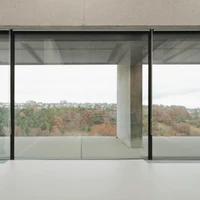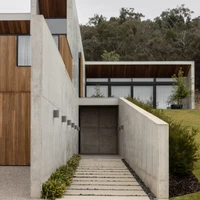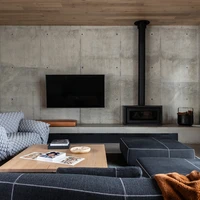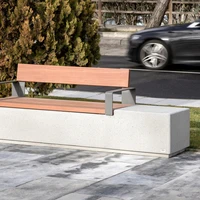Constructing with concrete: hardcore projects and products
With many eco-friendly cement alternatives racing through to market, the concrete revolution could be here to stay. These examples highlight the advantages of the age-old, but on-trend, material.
September 20, 2022 | 10:00 pm CUT

House in Majaburu’s single-use of concrete as a structural component and facade leaves wide open apertures to take in its tropical views. Photo: Ooki Jingu
Widely recognised as being responsible for 8% of global CO2 emissions, concrete should be a blacklisted material, relegated to the shameful annals of architectural history. Rapid global urbanisation, however, will ensure its unequalled production simplicity and structural strength help retain concrete’s firm grip on the construction industry.
If you can’t beat it, improve it: is the industry’s mantra on innovation, currently developing various alternatives to concrete or its constituent parts and admixtures. So with concrete set for the environmental greenlist, the concrete revolution – using the material as aesthetic exterior facade, interior decoration and fittings or even in furniture and lighting, as well as a structural framework – is free to continue.



Held up by thin concrete fins, hollow concrete bands wrap around the Geo- and Environmental Centre in Tübingen, Germany, sandwiching the light in-between. Photos: Brigida Gonzalez
Concrete in commercial architecture
At the Geo- and Environmental Centre in Tübingen, Germany, itself a monument to sustainability, concrete is used as a decorative outer shell, as well as the building’s structural support. Where typically construction sees a concrete framework covered with an aesthetic and weathertight facade, project architects Kaan Architecten decided to flip the two, wrapping concrete bands around the mixed-height structure at opposing ends. Holding the bands in place with thin, load-bearing concrete fins allows more flexibility with the internal layout, as well as wide apertured glass windows.


Both House in Majaburu (top) and the Blade House (middle, bottom) connect exterior and interior scenes with concrete. Photos: Ooki Jingu (top), Timothy Kaye (middle, bottom)
Residential properties with concrete exteriors and interiors
Concrete’s adaptable use as a structural material, exterior facade and aesthetic interior finish made it an ideal choice for the limited material palette of the limited budget House in Majaburu, nestled in the natural environment of Okinawa Island, Japan. Similar to the Geo- and Environmental Centre in Germany, wide-open window apertures introduce expansive views of the private home’s rich tropical environment and the sea, while the use of concrete as an interior finish contrasts with warm natural wood and brass fittings.Concrete brings breathtaking scale to the open, double-storey spaces as well as decorative depth and character to the living zones
Concrete is also used in both the exterior and interior environments of the Blade House in Albury, Australia, at first funnelling residents through a tunnel entrance before forming a spine that runs through the property. Concrete brings breathtaking scale to the open, double-storey spaces as well as decorative depth and character to the living zones, continuing to enclose an outdoor fireplace and terrace on the home’s other side.



Excavating the structural concrete inside the Shiroiya Hotel’s frame, Sou Fujimoto Architects combined it with a lighting installation to suit the revealed industrial style. Photos: Katsumasa Tanaka
Concrete reuse
Sustainable material research means a predilection for concrete won’t always mean extra CO2, but there are other eco-friendly options before then. As a favoured construction material for almost a century, many buildings already use concrete but hide it away, its inherent aesthetic value lost to the styles and trends of the time. With concrete’s recent rise in popularity, however, there’s reason for redevelopment projects to shed unnecessary interior clothing and stand proud in their beautiful naked form.Many buildings already use concrete but hide it away, its inherent aesthetic value lost to the styles and trends of the time
Sou Fujimoto Architects’ Shiroiya Hotel in Maebashi, Japan, has done just this, stripping off to reveal the beauty of the building underneath. ‘By taking down the floors and exposing the rough concrete surface,’ explain the architects, the building’s staircases interact with an installation of Leandro Erlich’s lighting pipes, themselves inspired by industrial water pipes that would typically have run alongside the original composition.


Dade Design’s bespoke kitchens (top) and Kast’s (middle) and ConSpire’s (bottom) colourful, moulded washbasins show how watertight sealed concrete can be formed into the perfect shape
Concrete furniture, fittings and lighting
Although porous in its initial form, when properly sealed, concrete has a smooth, durable finish that’s easy to clean, making it an ideal substance to form kitchen and bathroom surfaces, like the bespoke kitchen worktops or fully-fitted kitchens available from Dade Design. Meanwhile, concrete’s ability to mould into complex shapes ensures it keeps both strength and durability while set in any form. Striking and colourful feature washbasins like Vos by Kast Concrete Basins and Diamond from ConSpire Design Basins show off how perfect curves or sharp edges can be created with ease.

Durbanis’ Log series (top) adds soft wood tones to make hardwearing urban furniture more welcoming, while Magis’ Chair_One (middle) and GANTLights’ T series (bottom) contrast it with colour and shine
The unique, unpredictable patterns naturally present on concrete surfaces, along with its hard, cool and stable nature, provide an interesting base to contrast with warmer, softer materials and tones such as rich wood, as in Durbanis’ Log series of hardwearing exterior public benches; the vibrant purity of colour, a highlight of Magis’ die-cast aluminium Chair_One or the glinting elegance of GANTLights’ B, C and T series, combining light or dark concrete with accenting gold, silver, copper or brass.
© Architonic
Head to the Architonic Magazine for more insights on the latest products, trends and practices in architecture and design.
Project Gallery


























![Display product [T1] Concrete & Gold - Silver - Copper from manufacturer GANTlights](https://media.architonic.com/m-on/10002487/product/20190897/gantlights_t1--concrete---gold---silver---copper_ef0aac5f.jpeg?width=300&height=300&fit=inside&crop=true&format=webp&quality=90)
![[T1] Concrete & Gold - Silver - Copper](https://media.architonic.com/m-on/10002487/product/20190898/gantlights_t1--concrete---gold---silver---copper_7ad37b1a.jpeg?width=44&height=44&fit=inside&crop=true&format=webp&quality=90)
![[T1] Concrete & Gold - Silver - Copper](https://media.architonic.com/m-on/10002487/product/20190899/gantlights_t1--concrete---gold---silver---copper_61529ca8.jpeg?width=44&height=44&fit=inside&crop=true&format=webp&quality=90)












